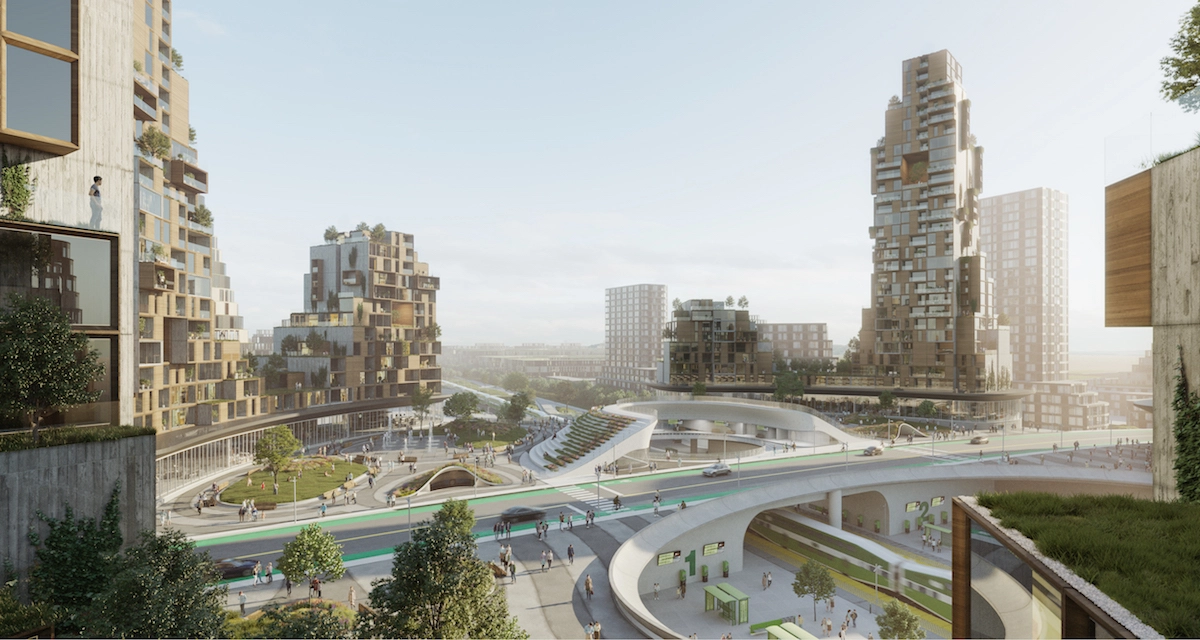As an architect invested in the future of sustainable design, I find myself constantly inspired by the innovative approaches taken in the UK. The landscape of sustainable architecture is evolving rapidly, and certain buildings stand out as exemplars of what can be achieved when creativity, technology, and environmental consciousness come together.
Here, I present my top ten sustainable buildings in the UK and explore what makes them exceptional.

1. Crystal, London
The Crystal in London is a shining example of sustainable design and one of the world’s most sustainable buildings. It is entirely powered by renewable energy, with solar panels and ground source heat pumps providing the necessary power. What sets The Crystal apart is its educational mission, serving as a centre for dialogue and learning about urban sustainability.

2. The Edge, Leeds
Leeds’ The Edge is a beacon of modern sustainability. It is designed to be energy-positive, meaning it generates more energy than it consumes. This is achieved through a combination of solar panels, advanced insulation, and smart building management systems. The Edge is a testament to how office buildings can lead the way in reducing carbon footprints.

3. BedZED, London
The Beddington Zero Energy Development (BedZED) in South London is one of the UK’s pioneering sustainable communities. BedZED combines innovative design with practical solutions for reducing energy consumption and carbon emissions. The use of local, recycled materials and a strong focus on community-led living make it a standout example of sustainable housing.

4. The Co-op Headquarters, Manchester
One Angel Square, the Co-op’s headquarters in Manchester, is a marvel of sustainable architecture. Its innovative double-skin façade and use of natural light drastically reduce energy consumption. Additionally, the building’s heating and cooling systems use advanced heat recovery and natural ventilation, setting a new standard for corporate environmental responsibility.

5. The Bullitt Center, London
Often touted as the greenest commercial building in the world, The Bullitt Center in London operates entirely on renewable energy and features a rooftop solar array, rainwater harvesting system, and composting toilets. Its design not only minimises environmental impact but also promotes occupant health and well-being, making it a holistic model of sustainable design.

6. The Hive, Worcester
The Hive in Worcester is the first fully integrated public and university library in the UK. Its sustainable features include a green roof, natural ventilation, and an on-site biomass boiler. The Hive’s commitment to sustainability extends beyond its physical structure to its role as a community hub, fostering environmental awareness and education.

7. The Gateway Building, Leeds
At the University of Leeds, the Gateway Building showcases how educational institutions can lead in sustainability. The building uses a combination of passive solar design, high-performance insulation, and rainwater harvesting to minimise its environmental footprint. It serves as a living lab for students and researchers dedicated to sustainable development.

8. The Bright Building, Manchester
The Bright Building at Manchester Science Park is designed with sustainability at its core. Featuring a highly efficient thermal envelope, extensive use of natural light, and renewable energy sources, it stands as a beacon of sustainable commercial architecture. Its design promotes flexibility and future-proofing, ensuring it remains at the forefront of green building practices.

9. Lancaster Cohousing, Lancaster
Lancaster Cohousing is an outstanding example of a community-driven approach to sustainable living. This development emphasises low-impact living with passive solar design, super-insulated homes, and a shared renewable energy system. Its cooperative ownership model and community ethos highlight the social dimension of sustainability.

10. The Eden Project, Cornwall
The Eden Project in Cornwall is not just a visitor attraction but also a powerful statement on sustainability. The biomes, which house diverse plant species, are constructed using sustainable materials and methods. The project focuses on educating visitors about the natural world and the importance of conservation, making it a unique blend of architecture and environmental advocacy.
These ten buildings exemplify the best of sustainable architecture in the UK, each bringing something unique to the table. Whether through cutting-edge technology, innovative design, or a commitment to community and education, they show that sustainability and architectural excellence can go hand in hand. As an architect, I find these buildings not just inspirational but also a clear indication that the future of design must be green. The work of architects in Newcastle and across the UK is proving that sustainable buildings are not just desirable but essential, and these examples are leading the way.
Historic Buildings with a Green Makeover: Balancing Conservation and Sustainability
The UK is a treasure trove of historic buildings, each telling its own unique story of the past. These structures, from medieval castles to Victorian warehouses, are a testament to our architectural heritage. However, in today’s world, the challenge lies in preserving these historic gems while also making them environmentally sustainable. This delicate balance is where the expertise of conservation architects comes into play, transforming aged edifices into green beacons of the future.
Historic buildings were not designed with modern sustainability standards in mind. Their original construction materials and methods often pose challenges when retrofitting for energy efficiency. The task for conservation architects is to ensure that any modifications respect the building’s historical integrity, while sustainable architects focus on integrating eco-friendly technologies without compromising the structure’s character.
Case Study: The Old Vic, London
One exemplary project is the refurbishment of The Old Vic theatre in London. This iconic building, dating back to 1818, underwent a significant green makeover. The retrofit included the installation of energy-efficient lighting, improved insulation, and a modern HVAC system designed to reduce energy consumption. The project demonstrates how historic theatres can be upgraded to meet contemporary sustainability standards while retaining their historical charm.
Techniques for Sustainable Conservation
Energy Efficiency Improvements
One of the primary methods for making historic buildings more sustainable is improving energy efficiency. This can involve installing double-glazed windows that replicate the appearance of original glass, adding internal insulation in ways that do not alter exterior appearances, and upgrading heating systems to more efficient models.
Renewable Energy Integration
Integrating renewable energy sources is another effective strategy. Solar panels can be discreetly installed on roofs or within the grounds of historic properties, as seen in the example of the Royal Albert Hall. Here, photovoltaic cells were integrated into the structure in a manner that did not detract from its iconic status.
Sustainable Materials
Using sustainable materials that match or complement the original construction is crucial. Conservation architects often source traditional materials that have a lower environmental impact or use modern equivalents that offer similar aesthetics but superior energy performance. For instance, lime-based mortars and paints are both environmentally friendly and sympathetic to older buildings’ needs.
Balancing Act: The Role of Architects
The role of sustainable and conservation architects is vital in achieving this balance. They must navigate strict heritage protection regulations while introducing modern sustainability features. Their work often involves close collaboration with historians, engineers, and environmental scientists to ensure that the buildings’ historical and architectural value is preserved.
Collaboration and Innovation
Successful projects typically result from innovative thinking and collaborative efforts. For example, the retrofitting of St. Pancras Renaissance Hotel involved a multidisciplinary team that managed to integrate modern sustainability practices without compromising the building’s Victorian Gothic splendour. The hotel’s heating and cooling systems were updated, and water-saving technologies were installed, all while maintaining the historical integrity of the structure.
Education and Advocacy
Furthermore, these architects play a crucial role in educating the public and stakeholders about the importance of sustainable conservation. By demonstrating the benefits of green makeovers, they advocate for wider acceptance and implementation of such practices across the industry.
Conclusion
The green makeover of historic buildings is not just a trend but a necessity in our journey towards a more sustainable future. Balancing the twin goals of conservation and sustainability requires the specialised skills of both conservation architects and sustainable architects. Their work ensures that our architectural heritage can be enjoyed by future generations, not as relics of a bygone era, but as living, breathing parts of our sustainable future. This balance of past and present is not just possible but essential, demonstrating that heritage and innovation can indeed go hand in hand.






